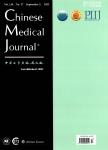Relationship between time in range and corneal nerve fiber loss in asymptomatic patients with type 2 diabetes
Relationship between time in range and corneal nerve fiber loss in asymptomatic patients with type 2 diabetes作者机构:'Department of Endocrinology and MetabolismShanghai Jiao Tong Universty Ailatede Sith People's HospitalShanghai Cinical Center for DiabetesShanghai Key Clinical Center for Metabolic DiseaseShanghai Diabetes IstuteShanghai Key Laboratory of Diabetes MellitusShanghai 200233China Shanghai Clinical Center for Metabolic DiseasesShanghai Key Laboratory of Diabetes MeliusShanghai Diabetes IstituteShanghai Jiao Tong University Alilatedae Sith People's HospitalShanghai 200233China Department of Endocrinology and MetabolismJinshan Branch of Shanghai Jiao Tong University Aflatedae Sixth People's HospitalShanghai 201500China
出 版 物:《Chinese Medical Journal》 (中华医学杂志(英文版))
年 卷 期:2022年第135卷第16期
页 面:1978-1985页
核心收录:
学科分类:1002[医学-临床医学] 100201[医学-内科学(含:心血管病、血液病、呼吸系病、消化系病、内分泌与代谢病、肾病、风湿病、传染病)] 10[医学]
基 金:supported by grants from the Shanghai Municipal Key Clinical Specialty, the National Natural Science Foundation of China(No. 8210087) the Interdisciplinary Program of Shanghai Jiao Tong University(No. YG2021QN105)
主 题:Continuous glucose monitoring Corneal confocal microscopy Time in range Type 2 diabetes
摘 要:Background: Corneal confocal microscopy (CCM) is a noninvasive technique to detect early nerve damage of diabetic sensorimotor polyneuropathy (DSPN). Time in range (TIR) is an emerging metric of glycemic control which was reported to be associated with diabetic complications. We sought to explore the relationship between TIR and corneal nerve parameters in asymptomatic patients with type 2 diabetes (T2DM).Methods: In this cross-sectional study, 206 asymptomatic inpatients with T2DM were recruited. After 7 days of continuous glucose monitoring, the TIR was calculated as the percentage of time in the glucose range of 3.9 to 10.0 mmol/L. CCM was performed to determine corneal nerve fiber density, corneal nerve branch density, and corneal nerve fiber length (CNFL). Abnormal CNFL was defined as ≤15.30 mm/***: Abnormal CNFL was found in 30.6% (63/206) of asymptomatic subjects. Linear regression analyses revealed that TIR was positively correlated with CCM parameters both in the crude and adjusted models (all P 0.05). Each 10% increase in TIR was associated with a 28.2% (95% CI: 0.595–0.866,P = 0.001) decreased risk of abnormal CNFL after adjusting for covariates. With the increase of TIR quartiles, corneal nerve fiber parameters increased significantly (allP for trend 0.01). The receiver operating characteristic curve indicated that the optimal cutoff point of TIR was 77.5% for predicting abnormal CNFL in asymptomatic ***: There is a significant independent correlation between TIR and corneal nerve fiber loss in asymptomatic T2DM patients. TIR may be a useful surrogate marker for early diagnosis of DSPN.



